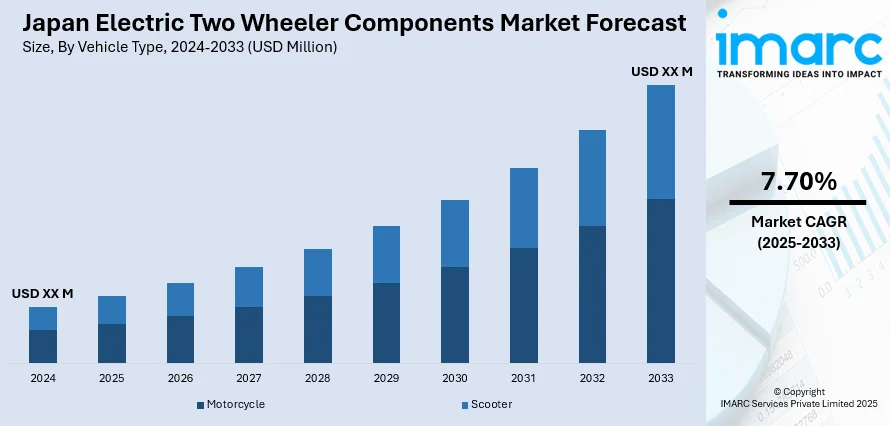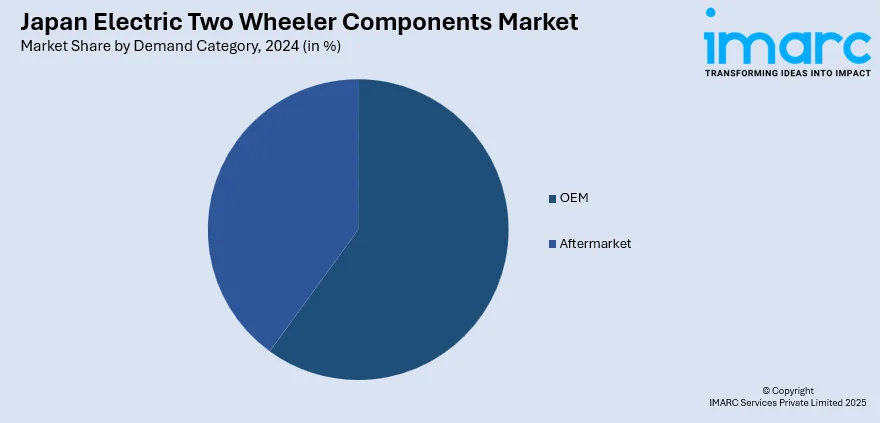
Japan Electric Two Wheeler Components Market Size, Share, Trends and Forecast by Vehicle Type, Demand Category, Component Type, and Region, 2025-2033
Japan Electric Two Wheeler Components Market Overview:
The Japan electric two wheeler components market size is projected to exhibit a growth rate (CAGR) of 7.70% during 2025-2033. The sector is underpinned by expanding environmental concern, official backing for clean transport, and increasing fuel prices. Urban congestion has picked up the pace for demand for compact, efficient transport. Developments in battery technology, smarts, and charging networks underpin further take-up. Industry cooperation to standardize components, including interchangeable batteries, underpins convenience and compatibility across brands. Consumer demand for eco-friendly and low-maintenance two-wheelers is also driving manufacturers to be innovative, placing electric two-wheelers at the forefront of Japan's future mobility.
|
Report Attribute
|
Key Statistics
|
|---|---|
|
Base Year
|
2024 |
|
Forecast Years
|
2025-2033
|
|
Historical Years
|
2019-2024
|
| Market Growth Rate 2025-2033 | 7.70% |
Japan Electric Two Wheeler Components Market Trends:
Advancements in Battery Technology
Battery technology in Japan's electric two-wheeler sector is evolving quickly, focusing on enhanced performance, reliability, and safety. Companies are designing batteries that provide faster charging, longer life, and reduced weight while delivering high energy output. These developments make electric vehicles more attractive for everyday use, overcoming typical worries such as range and charging convenience. Advances in battery design are also making them safer by delivering improved thermal control and more stable chemical compositions. Furthermore, newer batteries are being designed to be more compact, permitting more versatility in vehicle design. These developments are facilitating easier changeover by riders from conventional gasoline-powered bikes to electric bikes. As this continues to be the trend, it's anticipated to remain at the forefront of the rise and prosperity of Japan's electric two-wheeler market, fueling the transition to clean transportation.

Battery Swapping and Standardization
Japan’s electric two-wheeler market is rapidly adopting battery swapping to address charging delays and improve user convenience. With the goal of installing 15 battery stations throughout the city by the end of the fiscal year, Tokyo has started a battery-sharing program for electric motorcycles with detachable batteries. The capital wants all new motorcycles to be gasoline-free by 2035, and this effort helps achieve that aim. Major manufacturers like Honda, Yamaha, and others are collaborating to standardize battery formats, making them interchangeable across brands. This not only streamlines manufacturing and maintenance but also enhances consumer accessibility. Swapping depleted batteries with fully charged ones at dedicated stations drastically reduces downtime, making daily commuting more efficient. It also allows for lighter vehicle designs without large onboard batteries. As infrastructure expands and interoperability improves, battery swapping is reshaping Japan’s electric mobility landscape, boosting adoption and reinforcing the country's commitment to sustainability and a cleaner transport future.
Smart Connectivity and AI Integration
Japan electric two-wheelers are getting smarter with the incorporation of intelligent connectivity features. The riders now enjoy better digital interfaces, including touchscreens and smartphone apps, offering real-time feedback on vehicle status and performance. Such systems enable smooth navigation, remote diagnosis, and even customized riding modes. With increased incorporation of artificial intelligence, bikes can learn to adjust based on user behavior and road conditions. This technological evolution makes electric two-wheelers more intuitive and pleasant to use, turning them from mere transport machines into networked mobility solutions. It also fits with Japan's general drive toward smart cities and digital mobility communities. This movement is making electric vehicles not only greener, but smarter and more attuned to the needs of the modern urban commuter.
Japan Electric Two Wheeler Components Market Segmentation:
IMARC Group provides an analysis of the key trends in each segment of the market, along with forecasts at the country and regional levels for 2025-2033. Our report has categorized the market based on vehicle type, demand category, and component type.
Vehicle Type Insights:
- Motorcycle
- Scooter
The report has provided a detailed breakup and analysis of the market based on the vehicle type. This includes motorcycle and scooter.
Demand Category Insights:

- OEM
- Aftermarket
A detailed breakup and analysis of the market based on the demand category have also been provided in the report. This includes OEM and aftermarket.
Component Type Insights:
- Battery Packs
- DC-DC Converter
- Controller and Inverter
- Motor
- On-Board Chargers
- Others
The report has provided a detailed breakup and analysis of the market based on the component type. This includes battery packs, DC-DC converter, controller and inverter, motor, on-board chargers, and others.
Regional Insights:
- Kanto Region
- Kansai/Kinki Region
- Central/ Chubu Region
- Kyushu-Okinawa Region
- Tohoku Region
- Chugoku Region
- Hokkaido Region
- Shikoku Region
The report has also provided a comprehensive analysis of all the major regional markets, which include Kanto Region, Kansai/Kinki Region, Central/ Chubu Region, Kyushu-Okinawa Region, Tohoku Region, Chugoku Region, Hokkaido Region, and Shikoku Region.
Competitive Landscape:
The market research report has also provided a comprehensive analysis of the competitive landscape. Competitive analysis such as market structure, key player positioning, top winning strategies, competitive dashboard, and company evaluation quadrant has been covered in the report. Also, detailed profiles of all major companies have been provided.
Japan Electric Two Wheeler Components Market News:
- In August 2024, Honda and Yamaha agreed on an OEM partnership where Honda will supply electric Class-1 motorcycles—based on its EM1 e: and BENLY e: I models—to Yamaha for the Japanese market. This move builds on their prior collaborations and aligns with efforts to standardize swappable battery systems. The partnership aims to accelerate the adoption of electric motorcycles in Japan, especially for personal and business use, enhancing convenience and sustainability.
Japan Electric Two Wheeler Components Market Report Coverage:
| Report Features | Details |
|---|---|
| Base Year of the Analysis | 2024 |
| Historical Period | 2019-2024 |
| Forecast Period | 2025-2033 |
| Units | Million USD |
| Scope of the Report |
Exploration of Historical Trends and Market Outlook, Industry Catalysts and Challenges, Segment-Wise Historical and Future Market Assessment:
|
| Vehicle Types Covered | Motorcycle, Scooter |
| Demand Categories Covered | OEM, Aftermarket |
| Component Types Covered | Battery Packs, DC-DC Converter, Controller and Inverter, Motor, On-Board Chargers, Others |
| Regions Covered | Kanto Region, Kansai/Kinki Region, Central/ Chubu Region, Kyushu-Okinawa Region, Tohoku Region, Chugoku Region, Hokkaido Region, Shikoku Region |
| Customization Scope | 10% Free Customization |
| Post-Sale Analyst Support | 10-12 Weeks |
| Delivery Format | PDF and Excel through Email (We can also provide the editable version of the report in PPT/Word format on special request) |
Key Questions Answered in This Report:
- How has the Japan electric two wheeler components market performed so far and how will it perform in the coming years?
- What is the breakup of the Japan electric two wheeler components market on the basis of vehicle type?
- What is the breakup of the Japan electric two wheeler components market on the basis of demand category?
- What is the breakup of the Japan electric two wheeler components market on the basis of component type?
- What is the breakup of the Japan electric two wheeler components market on the basis of region?
- What are the various stages in the value chain of the Japan electric two wheeler components market?
- What are the key driving factors and challenges in the Japan electric two wheeler components market?
- What is the structure of the Japan electric two wheeler components market and who are the key players?
- What is the degree of competition in the Japan electric two wheeler components market?
Key Benefits for Stakeholders:
- IMARC’s industry report offers a comprehensive quantitative analysis of various market segments, historical and current market trends, market forecasts, and dynamics of the Japan electric two wheeler components market from 2019-2033.
- The research report provides the latest information on the market drivers, challenges, and opportunities in the Japan electric two wheeler components market.
- Porter's five forces analysis assist stakeholders in assessing the impact of new entrants, competitive rivalry, supplier power, buyer power, and the threat of substitution. It helps stakeholders to analyze the level of competition within the Japan electric two wheeler components industry and its attractiveness.
- Competitive landscape allows stakeholders to understand their competitive environment and provides an insight into the current positions of key players in the market.
Need more help?
- Speak to our experienced analysts for insights on the current market scenarios.
- Include additional segments and countries to customize the report as per your requirement.
- Gain an unparalleled competitive advantage in your domain by understanding how to utilize the report and positively impacting your operations and revenue.
- For further assistance, please connect with our analysts.
 Request Customization
Request Customization
 Speak to an Analyst
Speak to an Analyst
 Request Brochure
Request Brochure
 Inquire Before Buying
Inquire Before Buying




.webp)




.webp)












